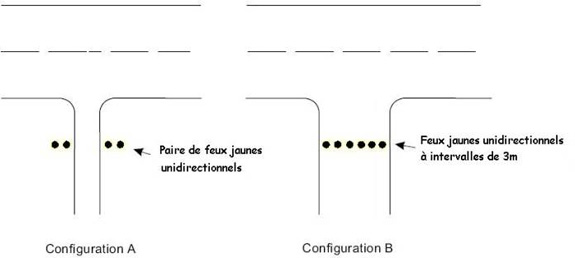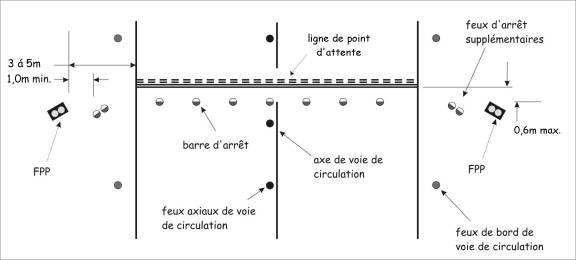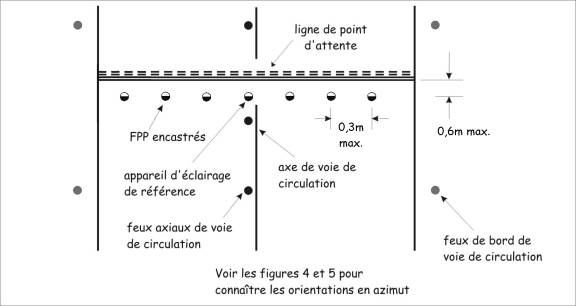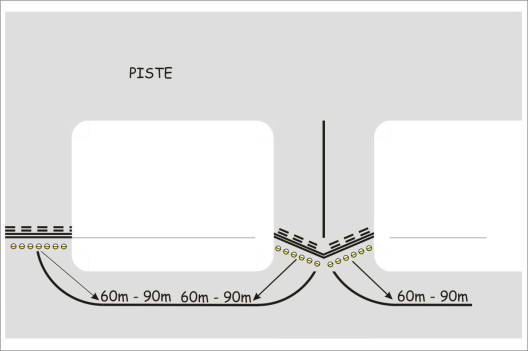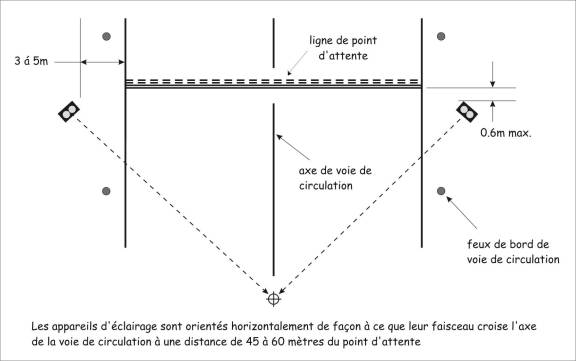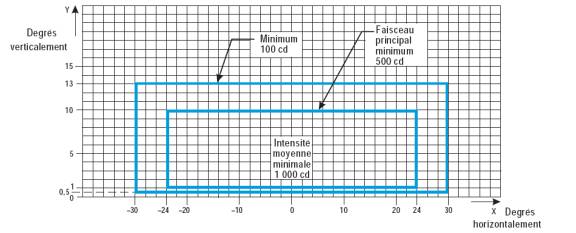Runway Guard Light Installation Criteria
| Issuing Office: | Standards | ||
|---|---|---|---|
| PAA Sub Activity Area: | Aviation Safety Regulatory Framework | Document No.: | AC 302-005 |
| Classification File No.: | A 5100-1 P/A | Issue No.: | 01 |
| RDIMS No.: | 4918459-v24 | Effective Date: | 2010-04-22 |
- 1. INTRODUCTION
- 2.0 REFERENCES AND REQUIREMENTS
- 3.0 BACKGROUND
- 4.0 DISCUSSION
- 4.1 Application
- 4.2 Configurations
- 4.3 Location of Elevated RGLs
- 4.4 Location of In-pavement RGLs
- 4.5 Light Beam Azimuth Orientation of In-pavement RGLs
- 4.6 Light Beam Orientation for Elevated RGLs
- 4.7 Power Supply and Circuitry
- 4.8 Control
- 4.9 Monitoring
- 4.10 Mode of Operation
- 4.11 Serviceability/Maintenance Criteria
- 4.12 Failure Modes of In-pavement RGLs
- 4.13 Secondary Power Supply
- 4.14 Colour
- 4.15 Photometrics
- 5.0 SUMMARY
- 6.0 CONTACT OFFICE
1.0 INTRODUCTION
This Advisory Circular (AC) is provided for information and guidance purposes. It may describe an example of an acceptable means, but not the only means, of demonstrating compliance with regulations and standards. This AC on its own does not change, create, amend or permit deviations from regulatory requirements, nor does it establish minimum standards.
1.1 Purpose
The purpose of this document is to provide information on methods and techniques for installation of runway guard lights (RGL), which are intended to caution pilots or vehicle drivers that they are about to enter an active runway.
1.2 Applicability
This document applies to all airport operators, manufacturers, suppliers, Transport Canada Civil Aviation (TCCA) Headquarters and regional personnel, and the aviation industry involved with the provision of equipment of this nature at Canadian aerodromes.
1.3 Description of Changes
Not applicable.
2.0 REFERENCES AND REQUIREMENTS
2.1 Reference Documents
It is intended that the following reference materials be used in conjunction with this document:
-
Aeronautics Act;
-
Part III, Subpart 02 of the Canadian Aviation Regulations (CARs)— Airports;
-
Transport Canada publication, TP 312, Edition 4, 1993-03 — Aerodrome Standards and Recommended Practices (revised 03/2005);
- Annex 14 to the Convention on International Civil Aviation (ICAO) Volume 1— Aerodrome Design and Operations.
2.2 Cancelled Documents
Not applicable.
2.3 Definitions and Abbreviations
The following definitions and abbreviations are used in this document:
-
RGL means Runway Guard Light;
-
RVR means Runway Visual Range;
- CCR means Constant Current Regulator.
3.0 BACKGROUND
The Canadian Aviation Regulations Part III Standards document TP 312 contains standards for RGL. This AC summarizes these standards and provides additional criterion that is deemed as an acceptable means for installation and operation.
4.0 DISCUSSION
4.1 Application
-
To support operations below RVR2600 (1/2 statute mile) down to RVR1200 (1/4 statute mile), RGLs are required. For operations from RVR4000 (3/4 statute mile) to RVR 2600 (1/2 statute mile), RGLs are also required where traffic density is high. To support ground operations below RVR1200 (1/4 statute mile) stopbars are required unless operational procedures exist to limit to one at any time the number of aircraft on the manoeuvring area.
-
In as much as visibility changes and facilities are fixed, the above criteria may result in collocation of RGL and stopbars. It is to be noted that article 5.3.20.4 of TP 312 stipulates that RGL configuration B (inset lighting) “shall not be collocated with a stopbar”. However, since the TP 312 is written primarily with respect to the display as provided to pilots, for the designer this article is interpreted to mean "operation" rather than actual physical location. It is possible to have a dual window inset fixture for which one window provides the RGL signal and the second window provides the stopbar signal. In such cases, the design and operation should be such that the light sources are interlocked so as to not emit signals simultaneously.
-
Where a taxiway has two hold positions: a primary position (closest to the runway), normally located at a Category 1 runway holding position, and a secondary position at a Category II/III holding position, the primary position would have RGLs and the secondary position a stopbar. These facilities should not be operated simultaneously for the reason that in low visibility the pilot stopping at the first hold position could be distracted by the display of RGL closer to the runway. An interlock should be provided so that the RGL at the primary position cannot be illuminated when the stopbar system is in operation.
- Except for conditions described in paragraphs (2) and (3), RGLs are operated when the visibility is less than RVR2600 (1/2 statute mile). It is strongly recommended that RGLs be operated both day and night in all visibility conditions.
4.2 Configurations
-
RGLs can be of two configurations, as shown in Figure 1. Configuration A is composed of elevated lights installed at each side of the runway holding position. Each light is designed with two lamps that flash alternatively. The lamps in each fixture flash at a rate of 45-50 flashes per minute.
- Configuration B is composed of lights installed across the taxiway at the holding position. The lights flash in a manner such that the even-numbered lights in the row pulse simultaneously and, as they extinguish, the odd-numbered lights then pulse simultaneously. Power is applied alternately to each set of fixtures for 50 percent ±0.5 percent, of the total cycle. Each fixture should pulse at a rate of 30-32 flashes per minute overall brightness settings.
Figure 1: RGL Configurations
4.3 Location of Elevated RGLs
-
Elevated and in-pavement RGLs serve the same purpose and are generally not both installed at the same runway holding position. However, if snow could obscure in-pavement RGLs, or there is an acute angle between the holding position and the direction of approach to the holding position, it may be advantageous to supplement in-pavement RGLs with elevated RGLs. Each elevated RGL fixture consists of two alternately illuminated, unidirectional yellow lights. In-pavement RGLs consist of a row of alternately illuminated, unidirectional yellow lights.
-
Elevated RGLs consist of two alternately illuminated, unidirectional elevated lights installed on each side of the taxiway and collocated with the runway holding position marking. The distance from the defined taxiway edge to the near side of an installed light fixture should be 3 to 5m.
-
If a stop bar is installed at the same runway holding position, the elevated RGL is located at least 1m outboard of the elevated stop bar light.
-
The positioning and height of the RGL should not interfere with the readability of the runway holding position sign, obscure any taxiway edge lights, or interfere with other airport lighting.
-
Elevated RGLs should be installed with an overall maximum height of 66cm (26 inches) above the adjacent taxi edge elevation.
- The elevated RGL should be provided with a tether to prevent the fixture from being blown onto neighbouring runways or taxiways if the frangible column should break under jet blast.
Figure 2: Configuration A (elevated) RGL with Stopbar
4.4 Location of In-pavement RGLs
-
In-pavement RGLs are centered on an imaginary line that is parallel to and 0.6m from, the holding side of the runway holding position marking as shown in Figure 3. The lights may vary from this imaginary line up to ±50mm in a direction perpendicular to the holding position marking. Holding position-marking locations are described in TP 312.
-
If a conflict with rigid pavement joints occurs, move both the runway holding position marking and the RGLs away from the runway the minimum distance required to resolve the conflict.
-
Lateral Spacing - Preferred Method. The lights are spaced across the entire taxiway, including fillets, holding bays, etc., at intervals of 3m ±50mm, centre-to-centre, as shown in Figure 3. The lights are spaced in relation to a reference fixture, which is installed inline (longitudinally) with existing or planned taxiway centerline lights. However, it is not intended that the reference fixture replace a taxiway centerline light. If a conflict between the reference fixture and a centerline light occurs, the reference fixture takes the place of an existing centerline light and a new centerline light is installed within allowed horizontal tolerances. If the holding position marking is intersected by multiple taxiway centerline markings, the reference fixture is set at the centerline that is used most often. A fixture whose outboard edge would fall at a point less than 0.6m from the defined edge of the taxiway (outboard edge of the taxiway marking) may be omitted. Individual fixtures may be moved laterally a maximum of ±0.3m in order to avoid undesirable spots: i.e., conduit and rigid pavement joints, etc.
-
If undesirable spots cannot be avoided in this way, fixtures may be moved no more than 0.6m using the following alternate method.
- Lateral Spacing - Alternate Method. An alternate method of spacing the lights should be followed if it is not possible to meet the preferred method specified in paragraph (2). If it is possible to meet paragraph (2) by allowing the reference fixture to be moved any amount laterally, then that method should be used. Otherwise, the lights should be spaced as uniformly as possible with a minimum spacing of 2.4m and a maximum of 4m.
Figure 3: Location: Configuration B (inset)
4.5 Light Beam Azimuth Orientation of In-pavement RGLs
-
Each in-pavement RGL fixture is installed so that the light beam faces away from the runway and is perpendicular to the runway holding position marking, as shown in Figure 4, within a tolerance of ±1 degree.
Figure 4: RGL Azimuth Orientation - Configuration B -
For some pavement configurations, it may be necessary to orient the lights at some angle to the marking. The lights should be aimed towards the aircraft on the centreline marking at a distance of approximately 60 to 90m from the RGL lighting as shown in Figure 5.
- Orientation of the light unit may be accomplished by the angular increments (30 degrees left or right) allowed by a 12-bolthole base. This will enable an orientation of 30 or 60 degrees as appropriate. If the desired orientation cannot be fully obtained in this fashion it may be necessary to rotate the base itself to the required angle.
Figure 5: RGL Azimuth Orientation - Configuration B - Curves
4.6 Light Beam Orientation for Elevated RGLs
- RGLs should be oriented to maximize the visibility of the light to pilots of aircraft approaching the runway holding position. The orientation aims the centre of the light beam toward the aircraft cockpit when the aircraft is between 45m and 60m from the holding position, along the predominant taxi path to the holding position. If these criteria cannot be met for all taxi paths to the holding position, consider using multiple fixtures aimed to adequately cover the different taxi paths. Alternatively use in-pavement fixtures, Configuration B.
Figure 6: RGLs Orientation - Configuration A - The vertical spread of the main beam (refer Figure 7) of the elevated RGL is ±8 degrees, the vertical aiming angle should be set for 8 degrees which will place the lower edge of the main beam along the taxiway pavement and upper edge at 16 degrees giving a height of 17.2m at 60m.
Figure 7: RGL Elevation - Configuration A
4.7 Power Supply and Circuitry
Power Supply:
-
Elevated RGLs are available as constant current fixtures (Mode 1) or constant voltage fixtures (Mode 2).
-
For Mode 1 type fixtures, these should be installed using separate regulators. This would allow independent control of the elevated runway guard lights and in-pavement guard lights. Confirmation should be obtained from the manufacturer to ensure that the regulator is compatible with the loads characteristic to flashing lights (typically a ferroresonant type of regulator).
-
If Mode 2 elevated RGLs are selected, they should be installed on a dedicated 120 Volt AC or 240 Volt AC circuit and in-pavement RGLs on their own series circuit. This provides for independent on/off control for operation during daytime visual meteorological conditions (VMC), if desired, and allows the RGLs to be turned off when the runway is closed. Furthermore, RGLs often need to be operated at a different intensity setting than that of runway or taxiway edge lights.
- If a small number of elevated RGLs are to be installed at an airport, it may be more economical to connect into a nearby lighting circuit than to install a dedicated circuit. However, there would be increased operational usage of the circuit to which the RGLs are connected in order to have the RGLs turned on when required, particularly during the daytime hours. Furthermore, a partial circuit load consisting of either elevated or in-pavement RGLs may cause unwanted pulsing of the steady-burning lights on the circuit. This effect, if present, will vary with the actual load and type of CCR.
4.8 Control
-
RGLs should normally be operated at 3 brightness levels. If RGLs are connected to nearby lighting circuit, arrangement should be made to provide suitable brightness levels or if the circuit is only one brightness level then a means should be provided to give at least two intensities at the RGL through use of a sensing device such as that of 4.8 (3).
-
Mode 1 RGL on series circuits should be supplied from a 3 step CCR. If a 5 step CCR is used, control connections should be made so that operation will occur at brightness steps 3, 3, 3, 4 and 5 corresponding to CCR steps of 1,2,3, 4 and 5 respectively. This is done for reason that elevated RGLs may appear dim when operated on steps 1 and 2.
- Brightness control for Mode 2 elevated RGLs is achieved by an integrated or remote sensing device (e.g. photocell) for each fixture.
4.9 Monitoring
RGL should be monitored by visual inspection. However, the airport may choose to install electronic monitoring by means such as power line carrier signals in order to facilitate maintenance surveillance. This will require a five-conductor lead (2 power, 2 monitoring, 1 ground).
4.10 Mode of Operation
-
In-pavement RGLs. An entire row of in-pavement RGLs pulse in such a manner that the even-numbered lights in the row pulse simultaneously and, as they extinguish, the odd-numbered lights pulse simultaneously. Power is applied alternately to each set of fixtures for 50 percent ±0.5 percent, of the total cycle. Each fixture pulses at a rate of 30-32 flashes per minute over all brightness settings.
- Elevated RGLs. Power is applied alternately to each lamp for 50 percent ±0.5 percent, of the total cycle. Each lamp pulses at a rate of 45 to 50 flashes per minute over all brightness settings.
4.11 Serviceability/Maintenance Criteria
Runway guard lights should be maintained to ensure that the maximum permissible outages are not exceeded during operations below RVR2600 (1/2 statute mile) as follows;
-
for elevated RGL, not more than one lamp failure per system (both sides); and
- for in-pavement RGL, not more than 2 lights per location and not more than 2 adjacent failures.
4.12 Failure Modes of In-pavement RGLs
In the event of a lamp failure, the remaining lights in the RGL row should continue to pulse normally.
4.13 Secondary Power Supply
RGL systems should be provided with secondary power supply in accordance with the associated runway type as identified in Table 8-1 of TP312.
4.14 Colour
RGL light units should be aviation yellow as indicated in Annex 14, Appendix 1, Figure A1-1 or traffic signal yellow per the ITE Standard for Vehicle Traffic Control Signal Heads (ST-017).
4.15 Photometrics
The RGL should meet the following photometric requirements as depicted by Figures 8 or 9 as follows:
Figure 8: Elevated RGL - Configuration A
Figure 9: In-pavement RGL - Configuration B
5.0 SUMMARY
In accordance with CAR Part III and TP312, airport operators are responsible for the provisioning of lighting facilities such as Runway Guard Lights to support operations below RVR2600 [1/2 statute mile], unless there is provision for stopbars or there is approved operational procedures in place.
6.0 CONTACT OFFICE
For more information, please contact the appropriate Regional TCCA Office – Aerodromes and Air Navigation.
Website: https://tc.canada.ca/en/corporate-services/regions
Suggestions for amendment to this document are invited, and should be submitted via the Transport Canada Civil Aviation Issues Reporting System (CAIRS) at the following Internet address:
https://tc.canada.ca/en/aviation/civil-aviation/civil-aviation-issues-reporting-system-cairs
or by e-mail at: CAIRS_NCR@tc.gc.ca
“Original signed by”
D.B. Sherritt
Director, Standards
Civil Aviation
AC 302-005 - Runway Guard Light Installation Criteria
(PDF, 637 KB)
